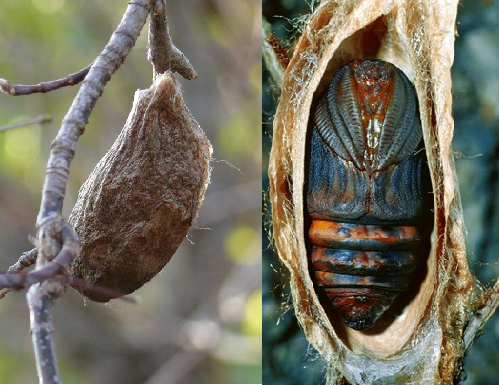The chrysalis can be considered the most mysterious stage in the metamorphosis of a butterfly. Chrysalises are the pupal form of the butterfly that follows directly after the larval (caterpillar) stage. Chrysalises are often mistakenly referred to as “cocoons.” Cocoons are actually the silk casing that some moths (and a few other insects) construct around their naked pupa.

A cocoon is the silk covering a moth creates around its pupa. In this photo the cocoon is cut away to reveal the pupa inside.
The word chrysalis originates from the greek word, chrysós (χρυσός) for gold. The term is derived from the metallic or gold coloration found on many chrysalises. Some are even completely gold!
Although the chrysalis may seem like a “resting” stage, it is not that at all. A lot is happening! As the caterpillar molts its final time to form the chrysalis, it releases enzymes that essentially cause its body to “melt” into a butterfly goo. Inside the chrysalis, specific clumps of cells called imaginal discs remain intact and direct the formation of specific tissues and body parts such as wings, antennae, and certain organs using the protein and nutrient-rich goo all around them. Slowly, the butterfly goo is transformed into the complete body of an adult butterfly.
Although the pupal stage is a non-mobile stage in the process of metamorphosis, many chrysalises can in fact wiggle and move. Certain species have a jointed abdominal segment that allows the chrysalis to wiggle in response to touch or movement. It is thought to be an instinctive response to repel or discourage predators or parasitoids.
One of the most spectacular aspects of chrysalises is the huge variance in appearance. Some have wildly effective camouflage, others are bright and eye-catching, some are smooth and glassy while others are sharp and spiky.

Some butterflies will use a silk girdle to attach the chrysalis to a twig like this Pachliopta aristolochiae. Photo © Horace Tan
At the Cockrell Butterfly Center we receive hundreds of chrysalises from around the world weekly. Opening the boxes to reveal the variety of pupae nestled in cotton is akin to Christmas. Each chrysalis will be carefully glued up in a natural hanging position. After a few days the adult butterfly will make its appearance and leave only the dry, shriveled shell of the chrysalis behind marking the end of the pupal stage.











